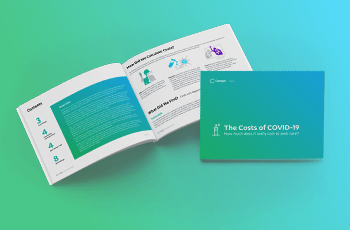Since early 2020, the United States has had almost 34 million cases of COVID-19 — with more than 600,000 deaths due to the virus — despite the precautions many states and communities implemented, such as social distancing, sheltering in place, and prohibitions of large public gatherings.
Recently, RAND researchers leveraged Castlight data to estimate the impact of small social events on COVID-19 transmission. To do this, they analyzed approximately three million U.S. households that have employer-based insurance and focused on two key data points: the birth dates of all household members and COVID-19 diagnoses within the household.
Specifically, the researchers wanted to see if those who were diagnosed with COVID-19 had a birthday or a family member with a birthday within the two weeks prior to their diagnosis.
The Results
The main findings of this analysis are:
- In counties with high COVID-19 rates, an individual’s chance of being diagnosed with COVID-19 was about 30% higher within two weeks of their birthday or that of a household member.
- The increase in cases was larger when a child had a birthday in the two weeks prior than when an adult had a birthday (15.8 per 10,000 vs. 5.8 per 10,000).
- There was no relationship between these results and regional political leanings (i.e., who the majority of the county voted for in the 2020 Presidential election), nor was there a link between these results and county-specific shelter-in-place policies.
“Our findings highlight an important tension with the pandemic,” said RAND’s Christopher Whaley, co-author of the study. “Social gatherings are a fabric for families and society as a whole. However, as we show, in high-risk areas, they can also flame the pandemic and expose households to COVID-19 infections.”
The analysis was performed on household transmissions between January and November 2020, before COVID-19 vaccinations became publicly available.
Looking Forward: Navigating Office Celebrations
Prior to the pandemic, company celebrations were a part of everyday office life. It wasn’t unusual for there to be multiple celebrations a month, whether celebrating a birthday, a holiday, or an exciting company milestone. Though much of the country is re-opening, we should still be cautious. The virus still exists, with new variants taking hold, and while over half of U.S. adults are fully vaccinated, there are still millions of Americans who are not.
Per CDC guidance, the safest route would be for those who are unvaccinated to continue to maintain social distancing and wear masks when engaging in social activities. Here are some tips to keep in mind if you elect to host office celebrations as your employees return to the office.
1. Limit the Size of Each Gathering
No matter what the occasion, make sure there’s enough space for people to maintain distance among themselves. Consider gathering in stages rather than getting the whole crew together at once. For example, you could invite different teams at different times, or you could allow people to sign up for spots that best fit into their schedule — making sure no time slot has too many attendees.
2. Celebrate Outside When Possible
Barring inclement weather, it’s still safest to gather outdoors. When you can, get together in nearby parks or pavilions or outdoor common spaces in the office building, such as a rooftop, balcony, or courtyard. Not only is the outdoor COVID-19 transmission rate much lower than the indoor rate, but gathering outside typically allows people more space to spread out.
3. Encourage Employees to Wear a Mask
Whether they choose not to get vaccinated or can’t due to a medical issue, unvaccinated employees are most vulnerable to contracting COVID-19. For that reason, it’s highly advised that all employees wear a mask for gatherings, especially if they are being held indoors. For example, if your company doesn’t require wearing a mask indoors, it might be prudent to have all employees wear masks as a precautionary measure during company social events.
It’s important that company leadership respects, normalizes, and socializes mask-wearing. No matter what the office policy is, if an employee chooses to wear a mask — whether it’s because they’re not vaccinated or because, despite being vaccinated, masks still make them feel safer — they should feel comfortable doing so.
4. Avoid Close Contact Near Food
The heart of many social events is near the food. To avoid having people gather in bunches near the food table, spread food and beverages out around the room so people don’t all flock to the same spot at once. You want to avoid having employees hovering over a cake or casserole dish at the same time. If the celebration includes a larger meal, avoid buffet-style service — instead, opt for personal boxed meals or provide employees with credits to a food delivery service so they can order their own meal. And, at least for the time being, it’s wise to avoid singing “Happy Birthday” and blowing out candles.
As the birthday study demonstrated, precautions like these are most important when the social event includes many people who are not vaccinated and in geographies where the incidence of COVID-19 infections is highest. They can help us avoid a return back to stringent shelter-in-place restrictions due to an uptick in COVID cases.


